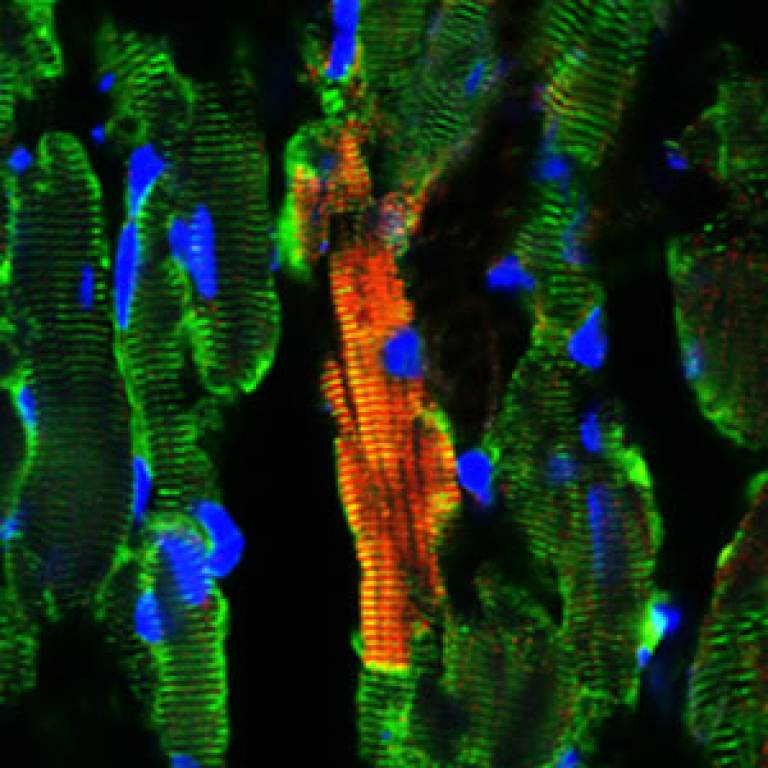Heart has built-in repair mechanism
8 June 2011
Researchers have for the first time succeeded in transforming a new type of stem-like cell in the adult heart, into heart muscle in mice.

The study, led by UCL scientists and published online today in Nature, proves the heart has dormant repair cells in its outer layer that may be re-activated. The research suggests that in the future hearts damaged by a heart attack could be encouraged to repair themselves.
The damage caused by a heart attack is currently permanent. It can lead to heart failure, which is debilitating, has a poor prognosis, and affects over 750,000 people in the UK.
British Heart Foundation-funded scientists working at UCL targeted stem-like cells called progenitor cells in the epicardium, the outer layer of the heart. In the embryo, these epicardium-derived progenitor cells (EPDCs) are able to transform into a number of specialist cells including heart muscle. Scientists thought this ability was lost in adults but researchers have managed to reactivate this potential.
They restored the EPDCs' embryonic potential by treating the healthy hearts of adult mice with a peptide molecule called thymosin β4 (Tβ4). This appeared to 'prime' the heart for repair. When damage to the heart occurred, a booster dose of Tβ4 was given, and this sparked the EPDCs to transform into new heart muscle and integrate with existing healthy muscle. Crucially, muscle is not formed if the EPDCs have not been pre-treated with Tβ4.
Explaining how this work might eventually translate into clinical practice, Professor Paul Riley (UCL Institute of Child Health), who led the research, said: "I could envisage a patient known to be at risk of a heart attack - either because of family history or warning signs spotted by their GP - taking an oral tablet, along the lines of a statin, which would prime their heart so that if they had a heart attack, the damage could be repaired."
However, treatments based on this method are several years away. Tβ4 enabled only a limited number of heart muscle cells to be generated. With BHF funding, the researchers now plan to carry out further research into the molecule. They hope to make it more effective or come up with alternative ways to activate the embryonic potential of EPDCs and eventually translate what they have found in mice into humans. This will also be helped by gaining better knowledge of the mechanism by which Tβ4 works.
Professor Riley added: "This is an important piece of work and something we've been working toward for some time. Our earlier research proved blood vessels could be regenerated in adult hearts but there were major doubts about whether the same might be true for heart muscle. This work has demonstrated a possible method for repairing hearts damaged by a heart attack and could have a major impact on future therapies to treat heart failure."
Professor Jeremy Pearson, Associate Medical Director at the BHF, said:
"To repair a damaged heart is one of the holy grails of heart research. This groundbreaking study shows that adult hearts contain cells that, given the right stimulus, can mobilise and turn into new heart cells that might repair a damaged heart. The team have identified the crucial molecular signals needed to make this happen.
"These results strengthen the evidence that in the future there may be a drug, or cocktail of drugs, that could be given to people whose hearts have been damaged by a heart attack, to prevent the onset of heart failure. This is why the BHF has launched its Mending Broken Hearts appeal to raise money for research to turn this vision into reality for heart patients as quickly as possible."
Image caption: New heart muscle cell derived
from EPDCs (red) has integrated with the existing heart muscle cells
(green).
Watch Professor Riley explain the research in the BHF video below.
UCL context
The UCL Institute of Child Health, in partnership with Great Ormond Street Hospital for Children NHS Trust, is the largest centre for paediatric research outside North America and plays a key role in training children's health specialists for the future. It is one of several world-class postgraduate institutes within the UCL School of Life and Medical Sciences.
Related news
Regenerative medicine success for muscles
 Close
Close

